After successfully building a PC, people often need to pay more attention to the value of placing the PC in the right place or on a suitable surface. Questions like “Where should you put your PC? What should I put under your PC? or Whether the carpet suits your PC?” are all essential questions for your PC’s optimal performance and longevity.
In short, your PC should be placed on a flat anti-static surface and consistently slightly elevated. Carpets should be avoided. The surface should provide adequate airflow, not contribute to dust build-up, and be static-free.
I’ll be sure to cover the aspects of the recommended surface for your PC and answer some of your PC’s placement.
TABLE OF CONTENTS
So What Should I Put Under My PC?
As mentioned, any static, dust-free flat surface should suit your PC. However, to thoroughly understand the recommended surface for putting your PC on, I recommend going over the following points:
1. Solid Flat Surface
For starters, anything you put under your PC should be flat, solid, and sturdy. This is a given.
A bumpy or flimsy surface increases the chance of restricted airflow or your PC tower flipping over.
So make sure the surface you put your PC on can easily handle the weight of your PC tower and more.
2. Carpet Should Be Avoided
This brings us to the next and perhaps the most crucial point. Often PC builders overlook the fact that carpets are HORRIBLE for placing your PC on. So, you shouldn’t put carpet under your PC.
This is especially true if the carpet strands are tall and thick.
Carpets are notorious for restricting the airflow PARTICULARLY for PC Towers with the PSU on the bottom.
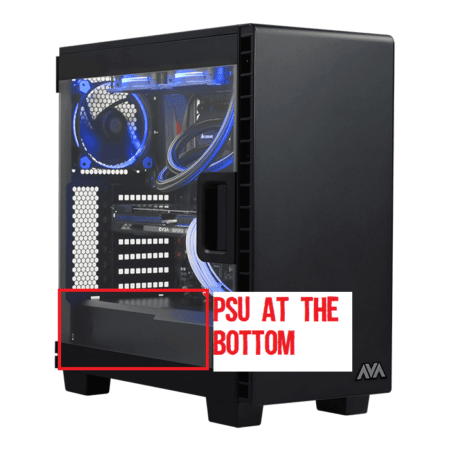
Most gaming grade and quality PC Towers have the PSU slot at the bottom.
In addition to that, carpets are dust magnets. Carpets, if not cleaned regularly, can attract dust which can then be sucked into your PC through the case fans leading to its build-up inside.
Dust build-up can further restrict the airflow and reduce your PC’s lifespan. In addition, dust can increase the chances of static damage to your PC parts.
And, of course, you will need to clean your PC, which can be a hassle regularly.
3. Wood, Tiles, Marble, and Static Free Mats are All Good Surfaces
Any static-free and hard surface should be suitable for putting under your PC.
Some of the recommended surfaces include:
- Hardwood
- Glass
- Marble
- Tiles
- Static Free Mats
Cardboard, foamboard, etc., are also suitable non-conductive surfaces. However, cardboard would not be able to support the weight of your PC Tower for long, and there is a high chance that over time, the legs of your PC’s Tower could sink inside the cardboard, thus restricting the airflow underneath the Tower.
Again, the aim should be a hard flat surface that is non-conductive (static-free).
4. At Least Slightly Elevated
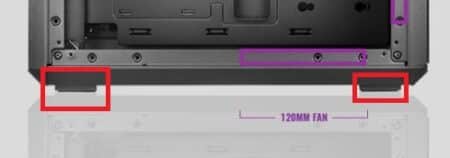
All desktop cases have legs for slightly elevating them off from the floor. This allows for better airflow and the dust to slide out from underneath.
In addition, some quality towers, like the one shown above, also have vents for adding an exhaust fan at the bottom (the one above has a vent for a 120mm exhaust fan).
The point is that there should always be some ground clearance between the PC Tower and the surface.
PC Towers placed on carpets and soft surfaces such as cardboard tend to sink, thus not only restricting the airflow from the bottom and blocking the dust from passing through underneath.
While PC cases have legs, investing in PC Tower Stands like the one shown below is also worth investing in.
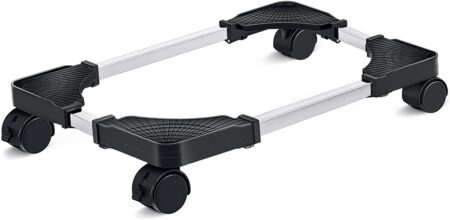
Also Read: How Much is a Motherboard?
Is It Better To Place the PC on a Desk or Floor?
Most enthusiasts and PC builders often love to place their PC on a desk. There are many benefits to doing this:
For starters, you save your PC from the dust that flows on the floor.
In addition, if you have built a gorgeous custom PC, it would suck to place it somewhere where it can’t be the center of attraction.
Placing your beautiful RGB custom-made desktop on the desk can be eye candy.
Of course, some precautions should be taken, such as making sure that it is NOT placed on a confined or shaky desk or next to an edge where there is a chance of the PC Tower tipping over.
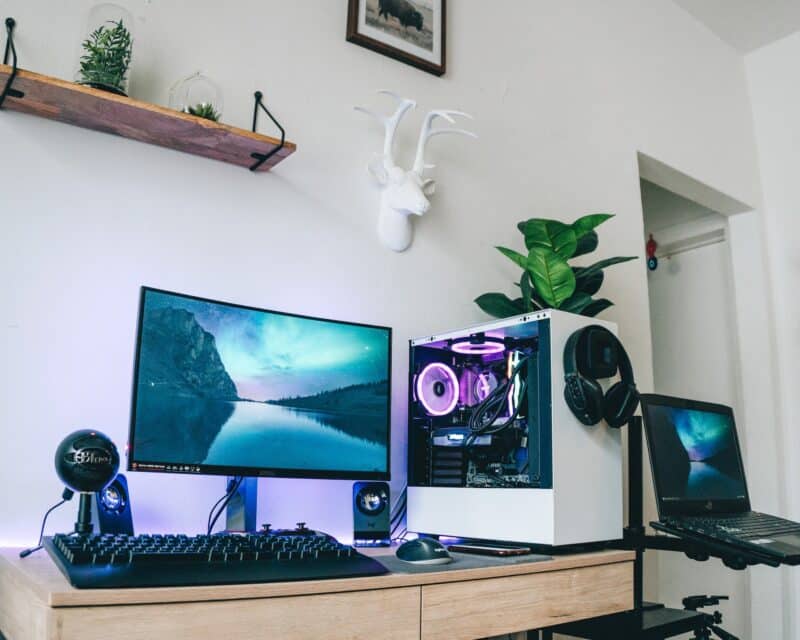
Another Consideration When Placing Your PC
Various other factors should be considered when choosing the right place for your PC.
Sufficient Clearance for Air Flow
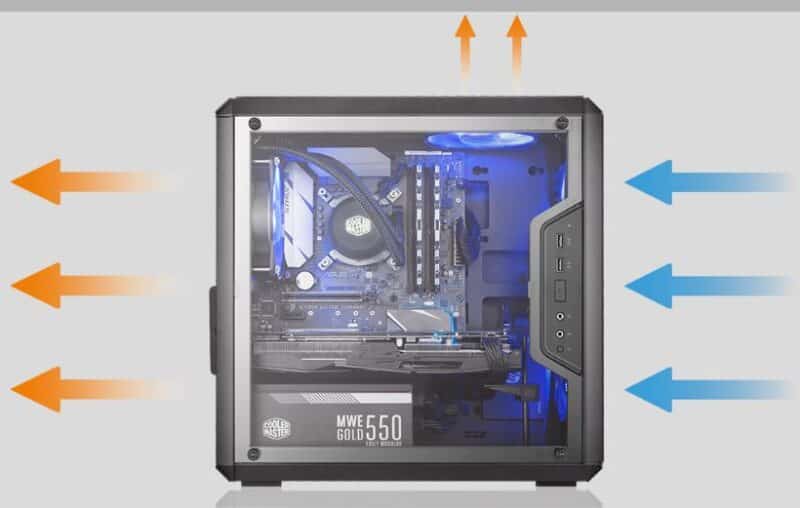
There are different opinions on how much breathing room should be provided, but it is agreed upon that clearance should be provided for airflow.
For instance, keeping the back of the Tower PC too close to the wall would raise the temperature inside, particularly if your PC is exhausting the air from the back, like the CoolerMaster Q300L above.
Here is what Crucial has to say regarding clearance:
You’ll want to leave two to three inches of space on all sides of your computer. – Crucial
I recommend a minimum of 3 inches (8 cm) from all sides, if not more.
Corners Should Be Avoided
The corners of a room tend to accumulate dust, particularly if you have a ceiling fan installed.
The natural airflow inside the room also tends to push the dust toward the corner; placing your PC Tower in the corner increases its chances of accumulating dust.
Cable Management
I could write an entire guide on cable management.
Bad cable management is not only ugly to look at, but it can also pose potential problems, such as accidental trips, and can also block the dust in their traps.
Could you try to find a place where you can minimize the clutter of cables? For instance, could you avoid placing your PC where other devices are connected, such as your phone chargers, etc.?
Away from Your Legs (Kicks)
Please remember to put your PC under your desk, where it can be subjected to accidental kicks.
Gaming rage or over-excitement can often lead one to lose control of their limbs which may lead to your PC getting tortured without you even knowing it.
Scratching the beautiful surface of your PC would be the least of your worry here, as repeated kicks can lead to internal hardware damage.
Also Read: How Difficult is it to Build a PC?
Final Words
TL;DR What should I put under my PC? Any hard, flat, and static-free surface should be suitable for placing under your PC.
You should avoid carpet as it restricts airflow and also attracts dust.
Cardboards are debatable. While they are flat and static-free, they do not have the sturdiness to support the weight of your PC and thus may either deteriorate or your PC may sink in over time.
Styrofoam is highly-flammable and hence could be better safety-wise.
Metallic surfaces should also be avoided as they are conductive and thus carry the risk of static damage. If your house suffers from earth fault, a metallic exterior would be the most dangerous idea to put under your PC.
My recommendation for surface include:
- Hardwood
- Marble
- Tiles
- Static Free Mat
And their most significant recommendation is to get a PC case stand.
Frequently Asked Questions
1. Can putting my PC on a soft surface cause any problems?
Yes, putting your PC on a soft surface can cause problems because it can restrict the airflow to the PC’s components. This can cause the components to overheat and potentially fail.
2. What are the benefits of using a specialized mat or pad for my PC?
Using a specialized mat or pad for your PC can provide a non-slip surface to keep the PC in place, as well as protect it from scratches or other damage. It can also help to absorb vibrations and reduce noise.
3. Are there any materials I should avoid using under my PC?
Yes, there are certain materials you should avoid using under your PC. For example, using metal or conductive materials can create a short circuit, while using materials that generate static electricity can damage your PC’s components.
4. How can I protect my PC from dust and debris when using a mat or pad?
To protect your PC from dust and debris when using a mat or pad, you can use a mat or pad that is easy to clean and can be wiped down regularly.
You can also use a dust cover or screen to protect the PC from dust and debris in the surrounding environment. Additionally, you can use an air compressor or compressed air to blow out any dust or debris that may accumulate inside the PC.
